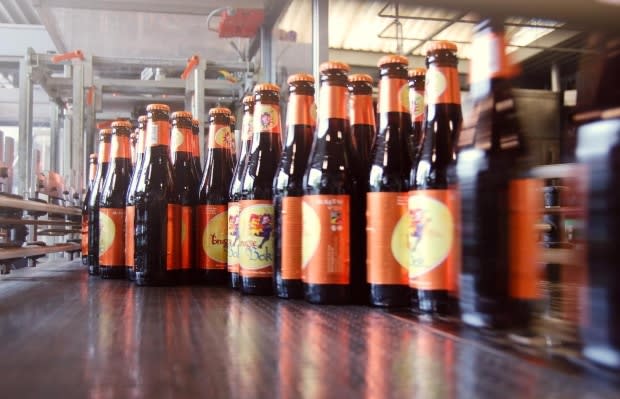From oil to beer: How pipeline technology could change the food industry
The Inventions of Oil is a CBC Edmonton series about oil and gas innovations hidden in our everyday lives
The story of a pipeline project that took years to get from drawing board to shovels in the ground might sound routine to Albertans in the thick of oil pipeline politics.
But what if it was a pipeline that transported beer?
It turns out the same technology that moves as much as 3.9 million barrels of oil from Western Canada every day is at the heart of an emerging effort around the globe to rethink how food, drinks and other products are shipped.
In Bruges, Belgium, for example, as much as 6,000 litres of beer per hour is pumped through a 3.2-kilometre underground pipeline that stretches from the centuries-old De Halve Maan brewery and restaurant to its new bottling plant outside of town.
The pipeline was first proposed in 2010 as an alternative to transporting beer by truck through the city's bumpy, congested streets, said Xavier Vanneste, the company's CEO and a sixth-generation brewer.
"In the beginning, people thought it was a joke," Vanneste said.
"Some people said the real estate value alongside the track would grow. Some people were making jokes about making tapping points and leaks, but then as soon as the project continued, and as soon as we advanced, you saw that people were really very enthusiastic about the idea."
The $5.6 million Cdn project took five years to acquire permits and financing, then another five months to build. By 2016, it was up and running.

With fewer trucks on the road, the brewery's carbon footprint is reduced. As well, the pipeline does a better job of keeping the beer carbonated and, without the need to connect and reconnect tanks, there's less oxidation along the way.
That, said Vanneste, has had a very important impact: better-tasting beer.
The evolution of pipelines
While pipeline systems for water date back to ancient civilizations, most modern technology has been driven by the oil industry, said Mahdi Vaezi, an assistant professor of engineering at Northern Illinois University. He researched alternative uses for pipelines while at the University of Alberta from 2009 through 2014.
"Any other application of pipelines, it's fair to say it's been developed based on oil pipelines," Vaezi said.
Over the last century, the oil and gas industries have led to advancements in pipeline materials, pump technology and leak prevention, he said.
There are 433,000 kilometres of oil and gas pipelines under the jurisdiction of the Alberta Energy Regulator. They would stretch well past the moon if placed end-to-end.
Alberta's pipelines predominantly are used for moving oil and gas products — natural gas, oil well effluent, fuel gas, sour natural gas and more — but pipelines can be used to move almost anything.
"Pretty much whatever you can think of has been transported through a pipeline," Vaezi said. His research found examples of pipelines moving coal, gold slime, limestone, iron ore and even wood chips.
The Belgian brewery may be the first to build an underground pipeline for beer but it's not the first food business to adopt the technology.
Other food producers are using it but on a much smaller scale, said Sylvain Charlebois, a Dalhousie University professor in Halifax who researches food transportation.
Pretty much whatever you can think of has been transported through a pipeline. - Mahdi Vaezi, engineering professor Northern Illinois University
The maple syrup industry uses what is essentially a mini-pipeline to connect the sap and water from thousands of trees, he said.
"On a maple syrup farm, those pipelines could extend well over 10 to 20 kilometres," he said.
Commercial dairy farmers adopted the technology in the mid-20th century, moving cow's milk from udder to tankers via a vacuum network of steel pipelines.
Charlebois said there is the potential for agribusiness to scale-up its use of pipeline technology.
"Prices of food are going up in the U.S. because they don't have enough drivers. With pipelines you don't need drivers," Charlebois said. "If you do it right you could actually make the country more food-secure."
Fishing for a new food transportation network
A move from steel pipelines to more durable thermoplastics was first introduced by Middle East oil companies to prevent corrosion.
In turn, the thermoplastics technology was used by Seattle-based Whooshh Innovations to make tube systems that move salmon over dams. A video of the process, showing salmon flying through a tube from one body of water to another, has garnered millions of views on YouTube.
According to Jim Otten, Whooshh's vice-president of engineering, the company first started working with Washington's agriculture department but pivoted when the founder saw live fish being assisted by helicopters during their migration.
Unlike underground pipelines, Whooshh's thermoplastic, above-ground tubes are flexible, allowing them to conform to oddly shaped objects. Companies in Norway use their tubes in fish-processing facilities, moving whole and gutted fish from one plant to another.
"We can put a salmon in the tube but we also can put an apple in the tube or a watermelon or something that's as weird as chicken or potatoes," Otten said.
Beyond a pipe dream
Moving agricultural products through pipelines was also a focus of Vaezi's research while at the U of A. Adapted pipelines could make it 50 per cent cheaper to move agricultural waste like straw and corn stover for use as biofuel, he said.
While Vaezi isn't convinced of the economic value of the large-scale transportation of food products, Vanneste, back in Belgium, is a believer. In fact, other wineries and breweries have been visiting to see if the technology could work for them, he said.
"Everybody is looking at how they can reduce their carbon footprint and how they can reduce heavy transportation in small city centres," he said. "This is actually a very positive solution to that."

